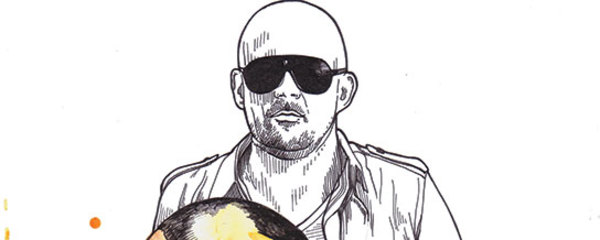Westbam: Off The Wall
What’s in a name? Quite a bit if you’re 41-year-old Maximilian Lenz, better known as […]
Westbam: Off The Wall
What’s in a name? Quite a bit if you’re 41-year-old Maximilian Lenz, better known as […]

What’s in a name? Quite a bit if you’re 41-year-old Maximilian Lenz, better known as Westbam. The moniker–a combination of his home province Westphalia with that of his musical idol Afrika Bambaataa–dates him as a teenager of the ’80s, and suggests what he would eventually become famous for: being one of the first DJ/producers to incorporate hip-hop influences (especially breaks) into house and techno. Though the name Westbam may be dated, Lenz stands for ideals that are timeless. He’s a Berlin legend, channeling punk energy to the dancefloor with his Low Spirit label (founded in 1985), co-founding the Loveparade and Mayday raves, and even representing his country during a 1988 DJ performance at the Seoul Olympics. XLR8R spoke with Lenz about the effects of reunification on the club scene.
XLR8R: What was your first encounter with hip-hop, which initially got you into DJing?
Westbam: As a teenager, I was into punk rock. In the early ’80s, a lot of punk rock was new wave and electronic. It was about trying something new and innovative. So when I first heard hip-hop, especially tracks like Bambaataa’s “Death Mix” that focused on mixing, it struck me as a new form of minimal electronic music. It was hardcore and not commercial and appealed to me.
What was the club scene like in Berlin before the Wall fell?
West Berlin was an island in East Germany and a weird place to live. In the rest of West Germany, you had to draw for military service, but in Berlin, you didn’t. It attracted freaks from all over the place. If you wanted a career, you would have gone to another big city. If you were a freak, you went to Berlin. People would listen to underground music, drink vodka, and take cheap drugs.
What were the clubs like?
In the early ’80s, the best club for dance culture was Metropol, this big, dark, half-gay spot. There were a lot of smaller spots playing industrial stuff. The first acid house club was the UFO club, an illegal cellar; a stinking, dark hole you’d enter by climbing down a ladder.
How did the club community react to the Wall falling?
Before that happened, we had radio stations in West Berlin broadcasting dance music on Saturday night. Kids from East Berlin would listen to them, so when the Wall fell, the scene got packed with these new kids that knew all the music. Suddenly UFO was packed, and the street would be lined with all those funny-looking East German cars. These days techno isn’t a fashion–it’s a way of life. But all the clubs are in East Berlin now; it’s by far the hipper place. All the changes are happening in East Berlin, where the West is like any other part of West Germany.
Did you ever play in East Berlin before the Wall fell?
A few times. Of course, the police would listen to every record when you crossed the border to find out if it had anything against the regime. That’s why we didn’t do it very often.
What was the inspiration behind starting the Loveparade?
It was a typical, anarchistic Berlin idea. We only had this little club, UFO, so we thought, “Let’s do the ultimate trick and go to the police and say we want to do a demonstration for peace and love. We’re citizens, right? We’re going to get police protection and have a party on Berlin’s main street. Let’s do something obvious, with weird people and weird sounds that people won’t understand; and if they want to join us, that’s cool.” It was thrilling. Now everybody says they were on the float during the first Loveparade in ’88, but the first one happened in ’89.

